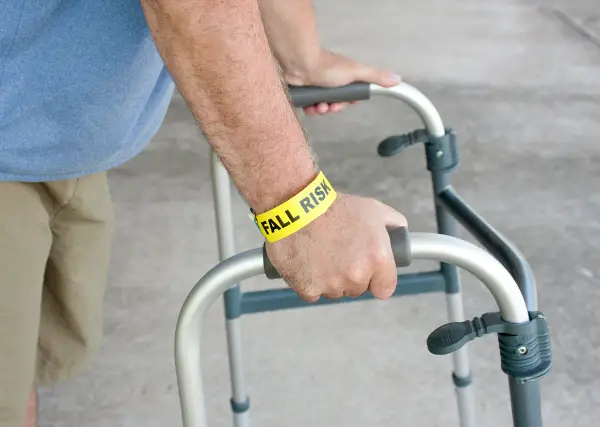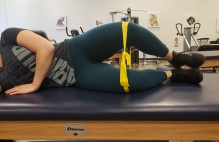A hip replacement can be a life changer! Your pain and mobility can greatly improve after surgery, improving your quality of life and daily activities. But…what happens when you start to feel a different pain in the hip? Hip Flexor tendonitis can sneak up on anyone after surgery and is a pain in the….well hip!
It’s very common for patients to develop Iliopsoas, or hip flexor, tendonitis after a hip replacement. Here’s what you can do to relieve that pain and get back to life!
What is Iliopsoas and Hip Flexor Tendonitis
The hip joint is the largest in the body! There are many structures that constitute this joint, such as muscles and ligaments.
One of the greatest muscle complexes of this region is the Iliopsoas – a high-powered team made up of three muscles: the Psoas Major, Psoas Minor, and Iliacus. This muscle group is commonly known as the hip flexors.
You can guess by the name what this muscle is made for: flexing the hip!

It is an essential worker when it comes to walking, sitting, standing, climbing. It stabilizes the pelvis, low back, and hip.
When overworked, the Iliopsoas can develop inflammation within the tendons, where the muscles connect to your bones, resulting in symptoms such as:
- Hip pain
- Groin pain
- Tenderness
- Snapping in the hip
What Causes Hip Flexor Tendonitis After a Hip Replacement
Irritation of the hip flexor muscles can occur due to the weakening of the gluteus medius muscle, one of the strongest contributors to hip stability.
When the strength of this muscle is inadequate, it can lead to asymmetries in the pelvis in regards to strength and stabilization. Thus, the hip flexor is overworked and becomes inflamed, leading to Iliopsoas tendonitis.

This pain is quite common after hip replacements and it can be very aggravating to the patient. That hip surgery was supposed to make you feel better, after all!
With the proper exercise therapy, you’ll be able to reduce your symptoms and strengthen your hip and return to the activities you enjoy.
How to Treat Iliopsoas Tendonitis After a Hip Replacement
Treating Iliopsoas tendonitis is tricky. It can be difficult to find a hip movement that doesn’t irritate your hip pain even more.
The key is finding the right balance between strengthening the gluteus medius while not aggravating the hip flexor.
One of the key points to remember is that you recently just had a hip replacement, so finding exercises that your hip can tolerate while also addressing the tendonitis is key.
4 Easy Exercises for Treating Iliopsoas Tendonitis After a Hip Replacement
Glute Bridge
Lay on your back and plant your feet on the mat about hip-width apart. Slowly lift your hips up off of the floor, contracting your glutes.

Aim to keep your body in a straight line from shoulders, to hips, to knees. Hold for a few seconds, then slowly lower back to the floor.
Try to maintain your knees hip-width apart, versus splaying out to the side.
Repeat 12x, holding 3 seconds each time. Complete 3 sets.
Seated Hamstring Curl
Sit on a chair and tie a resistance band in front of you, at ankle height. Loop the band around your ankle and scoot the chair back until the band is taut.
Place a rolled towel under your thigh (this will allow your hip to relax versus strain upwards). Pull your heel backward, contracting your hamstring on the back of your leg. Slowly return back to the start.

Control this movement and don’t let the resistance band speed you up.
Repeat 15x and complete 3 sets.
Side Lying Clamshell
Lay on your side with your hips stacked on top of each other, but straight (not bent in side-lying). Your knees will be bent to 90deg.

Keeping your feet together, slowly raise up your top knee. Try not to let your body roll to the side – keep those hips in a straight line! Hold for a few seconds, then slowly lower your knee back down.
Repeat 12x, holding 3 seconds each time. Complete 3 sets.
To advance this exercise, loop a resistance band around your knees.
Side Lying Hip Abduction Wall Slides
Find a section of your wall that is clear of furniture and decor. Lay on your side with your back, hips, and heels against the wall.
Begin to raise your top leg by sliding your heel up the wall, stopping at about 30 degrees. Slowly slide your leg back down.

Repeat 12x and complete 3 sets.
To advance this exercise, loop a resistance band around your knees or a strap weight around your ankle.
What to Avoid for Hip Flexor and Iliopsoas Tendonitis
Now you know that to clear up your hip pain you need to strengthen your hip stabilizers without aggravating your symptoms. Here’s what to avoid while treating your tendonitis:
- Increased pain in the hip: if you’re feeling more hip pain, time to stop the exercise and change position or find a different activity
- Repetitive hip flexion: activities that cause you to repeatedly raise your leg forward (like stair climbing or cycling) will likely irritate your pain more.
If you’ve tried treating your hip flexor tendonitis at home without success, think about visiting a Physical Therapist for a customized rehabilitation program. A PT can help you work through your condition by providing manual cues and a phased approach to make sure you’re performing exercises correctly.
Conclusion
Hip pain isn’t any fun, especially when that pain occurs after you’ve had a hip replacement surgery! Take the right steps to ensure your joint is strong and stable and avoid overworking your other muscles in the process. Iliopsoas tendonitis after hip replacement surgery is treatable and this guide will set you on the right path to recovery.
References:
Adib F, Johnson AJ, Hennrikus WL, Nasreddine A, Krocher M, Yen Y. Iliopsoas tendonitis after hip arthroscopy: prevalence, risk factors, and treatment algorithm. Journal of Hip Preservation Surgery. 2018; 5(4)P 362-369.
Bordoni B, Varacallo M. Anatomy, bony pelvis and lower limb, iliopsoas muscle. StatPearls. 2021. https://www.ncbi.nlm.nih.gov/books/NBK531508/
Philippon MJ, Decker MJ, Giphart JE, Torry MR, Wahoff MS, Laprade RF. Rehabilitation exercise progression for the gluteus medius muscle with consideration for iliopsoas tendinitis: an invite electromyography study. The American Journal of Sports Medicine. 2011. https://journals.sagepub.com/doi/abs/10.1177/0363546511406848
Disclaimer: The information provided in this post is for educational purposes only. This is not a substitute for a medical appointment. Please refer to your physician before starting any exercise program.

